

Two Heads Are Better Than One: The Benefits of Pair Testing. By Anneliese Herbosa "If you want to go fast, go alone.
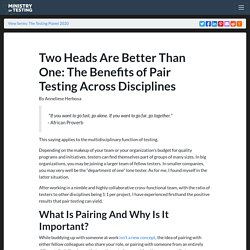
If you want to go far, go together. " - African Proverb This saying applies to the multidisciplinary function of testing. Depending on the makeup of your team or your organization’s budget for quality programs and initiatives, testers can find themselves part of groups of many sizes. In big organizations, you may be joining a larger team of fellow testers. After working in a nimble and highly collaborative cross-functional team, with the ratio of testers to other disciplines being 1:1 per project, I have experienced firsthand the positive results that pair testing can yield.
What Is Pairing And Why Is It Important? While buddying up with someone at work isn't a new concept, the idea of pairing with either fellow colleagues who share your role, or pairing with someone from an entirely different discipline, is one that continues to be a consideration as more agile teams are being formed. 40 Key Computer Science Concepts Explained In Layman’s Terms. Wiki Pages - googletest - Google C++ Testing Framework. V1_7_Primer - googletest - Getting started with Google C++ Testing Framework - Google C++ Testing Framework.
Google C++ Testing Framework helps you write better C++ tests.
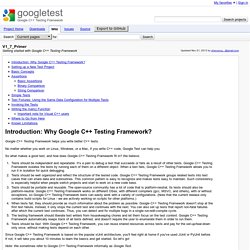
No matter whether you work on Linux, Windows, or a Mac, if you write C++ code, Google Test can help you. So what makes a good test, and how does Google C++ Testing Framework fit in? We believe: Tests should be independent and repeatable. It's a pain to debug a test that succeeds or fails as a result of other tests. Since Google C++ Testing Framework is based on the popular xUnit architecture, you'll feel right at home if you've used JUnit or PyUnit before. Note: We sometimes refer to Google C++ Testing Framework informally as Google Test. To write a test program using Google Test, you need to compile Google Test into a library and link your test with it. Once you are able to compile the Google Test library, you should create a project or build target for your test program.
If you still have questions, take a look at how Google Test's own tests are built and use them as examples. V1_7_FAQ - googletest - Tips and Frequently-Asked Questions about Google C++ Testing Framework - Google C++ Testing Framework. If you cannot find the answer to your question here, and you have read Primer and AdvancedGuide, send it to googletestframework@googlegroups.com.
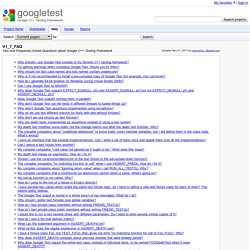
Why should I use Google Test instead of my favorite C++ testing framework? First, let us say clearly that we don't want to get into the debate of which C++ testing framework is the best. There exist many fine frameworks for writing C++ tests, and we have tremendous respect for the developers and users of them. We don't think there is (or will be) a single best framework - you have to pick the right tool for the particular task you are tackling. We created Google Test because we couldn't find the right combination of features and conveniences in an existing framework to satisfy our needs. Google Test is designed to be portable: it doesn't require exceptions or RTTI; it works around various bugs in various compilers and environments; etc. Writing Testable Code.
Blog Archive » Seven Kinds of Testers. Most of my work is teaching, coaching, and evaluating testers.
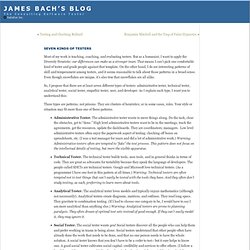
But as a humanist, I want to apply the Diversity Heuristic: our differences can make us a stronger team. That means I can’t pick one comfortable kind of tester and grade people against that template. On the other hand, I do see interesting patterns of skill and temperament among testers, and it seems reasonable to talk about those patterns in a broad sense. Even though snowflakes are unique, it’s also true that snowflakes are all alike. So, I propose that there are at least seven different types of testers: administrative tester, technical tester, analytical tester, social tester, empathic tester, user, and developer. These types are patterns, not prisons. Administrative Tester. When I’m sizing up a tester during coaching. Google Testing Blog. Developer Testing: How much test coverage do you need? - The Testivus Answer. Homepage -> Individual Weblogs -> Alberto Savoia -> How much test coverage do you need?
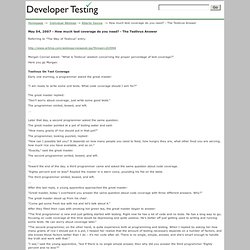
- The Testivus Answer May 04, 2007 - How much test coverage do you need? - The Testivus Answer Referring to "The Way of Testivus" entry: Morgan Conrad asked: "What is Testivus' wisdom concerning the proper percentage of test coverage? " Here you go Morgan: Testivus On Test Coverage Early one morning, a programmer asked the great master: “I am ready to write some unit tests.
The great master replied: “Don’t worry about coverage, just write some good tests.” The programmer smiled, bowed, and left. Later that day, a second programmer asked the same question. Ebooks. Books Recommended by Testers - Testing Circus. Test This Blog - Eric Jacobson's Software Testing Blog.